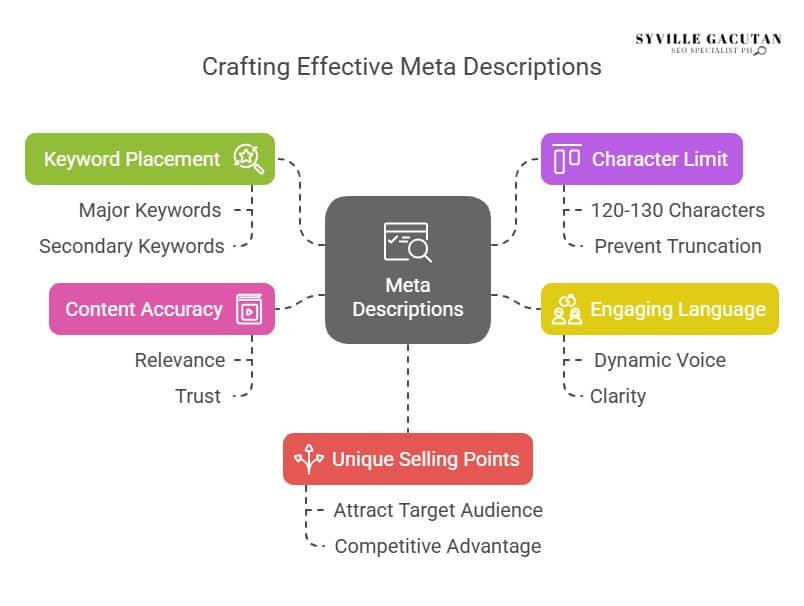
10 Tips for Crafting Effective Meta Descriptions
Crafting effective meta descriptions enhances your website’s visibility and click-through rates. Begin by using keywords strategically, then keep descriptions concise to avoid truncation. Use active voice to engage more effectively. Creating a sense of urgency and aligning content with user intent improves interaction. Ensure calls to action are engaging, and avoid duplicate descriptions to maintain unique SEO benefits. Stay faithful to content relevance and optimize for mobile users to adapt to varied devices. Conduct regular performance monitoring for continuous optimization. By knowing how to write effective meta descriptions, you can significantly boost your search engine performance and user engagement. Explore each strategy deeper for optimal results.
Key Takeaways
- To increase visibility without keyword stuffing, properly place major and secondary keywords.
- To prevent truncation and keep readers interested, keep meta descriptions between 120 and 130 characters.
- To improve clarity and establish a connection with readers, use engaging language and dynamic voice.
- Ensure meta descriptions accurately reflect landing page content for relevance and trust.
- Highlight unique selling points to differentiate from competitors and attract target audiences.

1. Use Keywords Wisely

In the realm of search engine optimization, the judicious use of keywords within meta descriptions is paramount to enhancing visibility and click-through rates. Proper keyword placement ensures that search engines and users alike recognize the relevance of your content, directly influencing the likelihood of a page being selected from search results.
When crafting meta descriptions, it is crucial to strategically position keywords to ensure they naturally fit within the narrative, thereby maintaining coherence and appeal.
Keyword density, while important, should be managed carefully to avoid the pitfalls of keyword stuffing, which can lead to penalties and diminished user experience. Striking an optimal balance requires thorough keyword research, allowing for the identification of both primary and secondary keywords that align with user intent.
By understanding the frequency and context in which terms are used, one can effectively tailor meta descriptions to reflect genuine relevance.
Long tail keywords, characterized by their specific and targeted nature, often offer a competitive edge in niche markets. Their inclusion can significantly improve the precision of search results, catering to users who are closer to making a decision or purchase.
Thus, incorporating long tail keywords into meta descriptions not only enhances keyword relevance but also aligns content with the nuanced queries of the target audience.
Ultimately, the art of using keywords wisely in meta descriptions hinges on a harmonious blend of keyword placement, density, and relevance. By investing time in comprehensive keyword research, content creators can craft meta descriptions that resonate with both search engines and users, driving traffic and engagement effectively.
2. Keep It Concise

Frequently, the effectiveness of a meta description hinges on its brevity, making conciseness a vital element in crafting an impactful message. With search engines typically displaying only 150-160 characters, adhering to a strict character limit ensures that your message appears complete and avoids truncation. It is crucial to balance this brevity with readability factors, ensuring the description remains clear and engaging to capture the attention of potential visitors.
| Key Element | Description |
| Character Limit | Stay within 150-160 characters to avoid truncation. |
| Readability | Use simple language for clarity and quick comprehension. |
| Emotional Triggers | Incorporate words that evoke curiosity or a sense of urgency. |
| Brand Voice | Maintain consistency with the overall tone of your brand. |
To maximize the effectiveness of a meta description, it is essential to incorporate emotional triggers that resonate with your audience. Words that evoke curiosity or urgency can significantly enhance click-through rates. Simultaneously, maintaining a consistent brand voice ensures that your meta descriptions align with your overall marketing strategy and strengthens brand recognition.
Testing strategies play a pivotal role in refining meta descriptions. By analyzing different versions, marketers can identify which phrasing or structure yields the best results. This iterative process not only enhances the appeal of meta descriptions but also contributes to improved search engine performance.
3. Use Active Voice

An active voice is essential in crafting meta descriptions that are engaging and persuasive. It provides a dynamic and direct approach to communication, enhancing the immediacy and impact of the message. By employing active voice, you ensure that your meta descriptions resonate with readers, facilitating a stronger connection. The benefits of using an active voice include improved clarity and a consistent tone, both of which contribute to a more effective meta description.
Active voice benefits a meta description by making it more engaging and straightforward. This style of writing prioritizes the subject performing an action, which naturally leads to more vivid and compelling language. For instance, rather than stating “The product is loved by users,” an active voice would assert, “Users love the product.” This shift not only enhances clarity but also reinforces a direct connection with the reader, inviting them into the action rather than positioning them as passive observers.
Furthermore, using engaging language through an active voice ensures that the tone remains consistent throughout your meta description. A consistent tone is crucial for maintaining professionalism and fostering trust. When the tone wavers, it can create confusion or disinterest, undermining the effectiveness of the message. An active voice helps maintain the desired tone, guiding readers smoothly through the content.
4. Create a Sense of Urgency:

Building on the clarity and engagement achieved through an active voice, creating a sense of urgency is another vital element for effective meta descriptions. In the fast-paced digital landscape, capturing a reader’s attention quickly is crucial. One way to accomplish this is by leveraging time-sensitive offers. Phrases such as “limited time only” or “ending soon” can motivate users to click through, as they highlight opportunities that may not be available later. This not only piques interest but also encourages immediate action.
Incorporating emotional triggers in your meta descriptions can further enhance urgency. By appealing to a reader’s feelings, you can create a connection that compels them to explore further. For instance, using words like “exclusive” or “don’t miss out” can evoke a fear of missing out, a powerful motivator in today’s consumer mindset.
Scarcity tactics, such as mentioning limited quantities or exclusive access, can also be effective. When potential customers perceive a product or service as scarce, their desire to obtain it increases. This psychological principle can be leveraged in meta descriptions to boost click-through rates.
Crafting compelling headlines that align with seasonal promotions can additionally create urgency. Phrases that tie into holidays or special events can make offers feel more pertinent and timely. For example, “Get Ready for Winter with Our Holiday Discounts!” not only provides a compelling reason to click but also ties the offer to a specific time of year, reinforcing its immediacy.
5. Address User Intent

Understanding user intent is a critical step in crafting meta descriptions that truly resonate with your audience. By pinpointing what users are seeking when they type a query into a search engine, you can tailor your meta descriptions to align with their expectations. This alignment not only enhances content relevance but also optimizes user engagement, as users are more likely to click on links that promise to meet their needs effectively.
To address user intent, begin by analyzing user behavior patterns and discerning the underlying search intent. Is the user looking for information, hoping to make a purchase, or perhaps seeking a specific service? Each of these intents requires a distinct approach in the wording of your meta descriptions. For instance, if the intent is informational, a concise summary highlighting key insights can draw clicks. Conversely, if transactional, emphasizing benefits or features can be more effective.
Content relevance is paramount. Ensure that your meta description accurately reflects the content on the landing page. Misleading descriptions might initially increase click through rates, but they ultimately harm user engagement and can lead to higher bounce rates. Users who feel deceived are less likely to trust your site in future searches.
Monitoring and analyzing how different meta descriptions perform can provide invaluable insights into user behavior. Adjusting your strategy based on this data ensures your meta descriptions consistently address user intent and maintain high click through rates.
6. Highlight Unique Selling Points
Showcasing your unique selling points (USPs) in meta descriptions can significantly enhance your web page’s appeal in search results. Effectively highlighting USPs requires a deep understanding of your target audience, as this knowledge allows you to tailor your message to resonate with their specific needs and preferences.
By focusing on what sets your product or service apart, you can capture the attention of potential customers and encourage them to click through to your website.
Incorporating emotional appeal into your meta descriptions can be a powerful strategy. By tapping into the emotions of your target audience, you can create a connection that transcends mere interest, fostering a sense of trust and anticipation.
This approach is particularly effective when combined with a strong brand voice that reflects your company’s values and personality, ensuring that your message is consistent and memorable.
Conducting a competitive analysis is essential in identifying your USPs. By examining what your competitors offer and how they position themselves, you can pinpoint the unique aspects of your own offerings and emphasize these in your meta descriptions.
This strategic differentiation helps you stand out in a crowded market.
Utilizing storytelling techniques can further enhance the appeal of your USPs. By weaving a narrative that highlights the benefits of your product or service, you can engage your audience on a deeper level, making your meta description not just informative but also compelling.
This narrative approach helps to create a vivid image of how your offering can improve their lives, making it an irresistible choice.
7. Create Engaging Calls to Action

The art of persuasion is central to crafting engaging calls to action (CTAs) in your meta descriptions. These concise prompts are not just mere suggestions—they are powerful tools designed to motivate your audience to take specific actions.
To create CTAs that resonate, consider the following strategies:
- Use Actionable Phrases: Effective CTAs employ strong, directive language that encourages immediate action. Words like “discover,” “explore,” “learn,” and “join” can inspire urgency and drive engagement.
- Incorporate Emotional Triggers: Connect with your audience on a personal level by integrating emotional triggers into your CTAs. Phrases that evoke curiosity, excitement, or a sense of exclusivity can significantly enhance the appeal of your message.
- Audience Targeting: Tailor your CTAs to address the specific needs and preferences of your target audience. Understanding what drives your audience will allow you to craft messages that speak directly to their motivations and desires, increasing the likelihood of a positive response.
- Apply Formatting Techniques: Use clear and concise language, and consider formatting techniques such as bold text or capitalization to make your CTA stand out. A well-formatted CTA can capture the attention of potential customers amidst the clutter of search results.
Furthermore, implementing testing strategies is crucial for refining your CTAs. A/B testing different versions of your meta descriptions can provide valuable insights into what resonates most with your audience.
8. Avoid Duplicate Descriptions
Duplicate descriptions can significantly undermine the effectiveness of your SEO strategy, leading to missed opportunities in search engine rankings. The importance of crafting unique meta descriptions cannot be overstated, as duplicate content pitfalls can diminish your online presence. Search engines prioritize pages with distinct and relevant meta descriptions, which directly influences SEO ranking impact. A thoughtful approach to meta uniqueness strategies not only enhances visibility but also improves user experience considerations, guiding visitors to content that is pertinent and engaging.
To avoid the negative repercussions of duplicate descriptions, consider implementing robust content management tips. These strategies should focus on tracking and updating meta descriptions regularly to ensure each page conveys a distinct message. The following table outlines key considerations:
| Aspect | Importance | Strategy |
| SEO Ranking Impact | High – Unique descriptions boost rankings | Utilize tools to identify duplicates |
| User Experience | Essential – Enhances user engagement | Tailor content to match search intent |
| Content Management | Crucial – Requires systematic oversight | Schedule regular audits and updates |
| Meta Uniqueness | Vital – Sets your site apart from competitors | Develop unique templates for consistency |
Understanding these elements allows for a more strategic approach to managing meta descriptions. By emphasizing meta uniqueness strategies, you can effectively circumvent duplicate content pitfalls. This proactive stance not only mitigates SEO ranking impact but also elevates the overall user experience. By systematically integrating these content management tips, you safeguard your site’s standing and ensure it remains competitive. Such diligence in avoiding duplicate descriptions is integral to maintaining a robust digital presence and achieving sustained SEO success.
9. Stay True to Content

Ensuring meta descriptions accurately reflect the content of the page is just as important as avoiding duplicates. A well-crafted meta description serves as a promise to the reader, indicating what they can expect. Therefore, maintaining content alignment is crucial to avoid misleading your audience and to fulfill their expectations effectively.
Here are four essential guidelines for staying true to your content:
- Conduct Relevancy Checks: Regularly review the meta descriptions to ensure they are not only accurate but also relevant to the page’s content. This practice helps in maintaining the trust of your audience and enhancing user experience.
- Ensure Tone Consistency: The meta description should mirror the tone of the content. If your page has a professional tone, the description should reflect the same. Consistency in tone reinforces the overall brand voice and creates a cohesive experience for the reader.
- Focus on Audience Targeting: Write meta descriptions with your audience in mind. Understand what they are seeking and address those needs directly. This approach will not only attract the right visitors but also increase engagement rates.
- Preserve Brand Voice: Each meta description should align with your brand voice. This ensures that your brand’s personality is communicated effectively, fostering recognition and loyalty among your audience.
10. Optimize for Mobile

Mobile optimization has become a fundamental aspect of crafting effective meta descriptions in today’s digital landscape. As the reliance on smartphones for accessing online content continues to grow, ensuring your meta descriptions cater to the mobile user experience is crucial. This includes understanding the constraints and opportunities presented by mobile devices to improve content visibility and enhance conversion rates.
One of the key considerations in optimizing for mobile is adhering to character limits. Mobile screens display less text, which means concise and precise meta descriptions are essential. Typically, aim for 120-130 characters to ensure your message is fully visible without truncation. A focus on strategic keyword placement within these limits can significantly impact search visibility and user engagement.
Responsive design plays a vital role in the mobile optimization process. Responsive design ensures that your web page and its meta descriptions are displayed correctly across various devices, enhancing the mobile user experience. This adaptability not only boosts usability but also positively influences conversion rates by simplifying the user journey.
| Mobile Optimization Factors | Importance |
| Character Limits | High |
| Responsive Design | Critical |
| Content Visibility | Essential |
| Conversion Rates | Vital |
Final Thoughts
Crafting effective meta descriptions is essential for improving your website’s visibility and click-through rates. By strategically using keywords, keeping descriptions concise, and employing active voice, you can engage users more effectively. Creating a sense of urgency and addressing user intent enhances interaction, while highlighting unique selling points differentiates your content in a competitive landscape. Regularly monitoring performance and avoiding duplicate or vague descriptions ensures that your meta descriptions remain relevant and impactful. As mobile usage continues to rise, optimizing for mobile users is crucial for maintaining engagement.
Need help perfecting your meta descriptions for better visibility and user engagement? Connect with Syville Gacutan, an experienced SEO Specialist in the Philippines. Syville can help you optimize your meta tags, refine your content strategy, and boost your website’s search performance. Contact Syville today to elevate your SEO strategy!